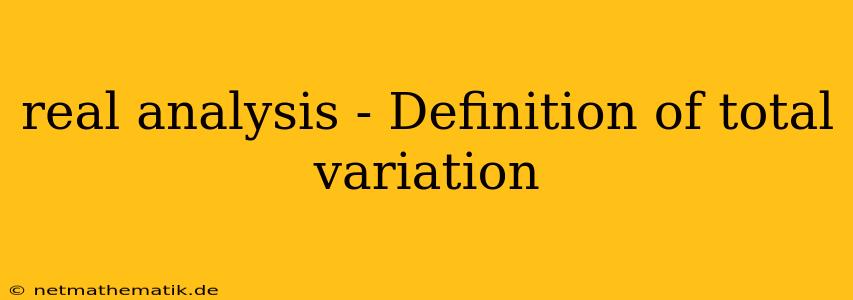Delving into the Essence of Total Variation in Real Analysis
The concept of total variation plays a crucial role in the field of real analysis, particularly when dealing with functions of bounded variation. While the name might suggest a measure of how much a function varies, it delves deeper into the notion of "how much" a function can change over its entire domain. Understanding this concept unlocks the door to exploring intricate properties of functions, paving the way for sophisticated mathematical analysis. Let's embark on a journey to unravel the definition of total variation and understand its significance in the realm of real analysis.
Definition of Total Variation
Before delving into the formal definition, let's intuitively grasp the essence of total variation. Consider a function defined on a closed interval [a, b]. The total variation of this function essentially quantifies the total amount of "up and down" movement the function exhibits within this interval. It's like measuring the total distance traveled by a particle along a path, regardless of the direction of movement.
Formally, the total variation of a function f(x) on the interval [a, b] is defined as:
1. For a function of bounded variation: The total variation, denoted as V<sub>f</sub>(a, b), is calculated as the supremum of the sum of absolute differences of function values over all possible partitions of the interval [a, b].
Let's break this down:
- Partition: A partition of [a, b] is a finite set of points {x<sub>0</sub>, x<sub>1</sub>, ..., x<sub>n</sub>} such that a = x<sub>0</sub> < x<sub>1</sub> < ... < x<sub>n</sub> = b.
- Supremum: The supremum represents the least upper bound of a set. In this case, we are looking for the largest possible sum of absolute differences over all partitions.
Mathematically:
V<sub>f</sub>(a, b) = sup<sub>P</sub> Σ<sub>i=1</sub><sup>n</sup> |f(x<sub>i</sub>) - f(x<sub>i-1</sub>)|
where P represents any partition of [a, b].
2. For an arbitrary function: The total variation can also be defined for functions that are not necessarily of bounded variation. In this case, the total variation might be infinite.
V<sub>f</sub>(a, b) = sup<sub>P</sub> Σ<sub>i=1</sub><sup>n</sup> |f(x<sub>i</sub>) - f(x<sub>i-1</sub>)|
where P represents any partition of [a, b].
Understanding the Definition
The essence of the definition lies in its attempt to capture the total amount of oscillation or "jumping around" of the function within the given interval. It considers all possible partitions of the interval and calculates the sum of absolute differences between consecutive function values for each partition. The supremum of these sums gives us the total variation.
Let's illustrate this with a simple example:
Consider the function f(x) = x<sup>2</sup> on the interval [0, 1]. Let's take two partitions:
- Partition 1: {0, 1/2, 1}
- Σ<sub>i=1</sub><sup>2</sup> |f(x<sub>i</sub>) - f(x<sub>i-1</sub>)| = |(1/2)<sup>2</sup> - 0<sup>2</sup>| + |1<sup>2</sup> - (1/2)<sup>2</sup>| = 3/4
- Partition 2: {0, 1/4, 1/2, 3/4, 1}
- Σ<sub>i=1</sub><sup>4</sup> |f(x<sub>i</sub>) - f(x<sub>i-1</sub>)| = |(1/4)<sup>2</sup> - 0<sup>2</sup>| + |(1/2)<sup>2</sup> - (1/4)<sup>2</sup>| + |(3/4)<sup>2</sup> - (1/2)<sup>2</sup>| + |1<sup>2</sup> - (3/4)<sup>2</sup>| = 1
The supremum of these sums, and indeed, the total variation of f(x) on [0, 1] is 1. This represents the total amount of "change" the function exhibits within the interval [0, 1].
Significance of Total Variation
The concept of total variation carries significant implications in various areas of mathematics, including:
- Functions of Bounded Variation: Functions with finite total variation are called functions of bounded variation. These functions possess desirable properties, such as being decomposable into the difference of two monotonic functions. This decomposition plays a crucial role in the study of integration, particularly in the context of Stieltjes integrals.
- Convergence of Functions: The total variation provides a measure of how "rough" or "oscillatory" a function is. Functions with smaller total variation tend to be smoother and exhibit better convergence properties. This is particularly relevant in the study of Fourier series and other areas of approximation theory.
- Measure Theory: The total variation of a function can be used to define a measure called the total variation measure, which plays a vital role in measure theory. This measure quantifies the "size" of sets in relation to the function's variations.
Conclusion
The concept of total variation, while seemingly abstract, lies at the heart of understanding the behavior of functions in real analysis. It provides a quantitative measure of a function's "oscillation" or "change" over its domain. This concept finds applications in a wide range of areas, including the study of functions of bounded variation, convergence properties of functions, and measure theory. By grasping the definition of total variation and its implications, we gain a deeper understanding of the intricacies of functions and their behavior in the realm of real analysis.
